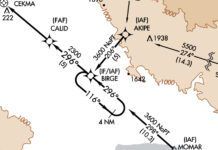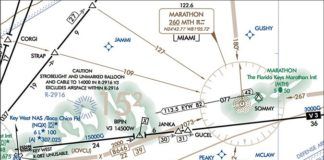Weather vs. Rules
I see a lot of confusion between the terms VFR and VMC (as well as IFR and IMC). VMC and VFR are often used interchangeably, in fact.
To me, VFR and VMC are in fact not the same because VFR refers to a set of rules that govern flight (visual flight rules), which includes airspace and so on. There are certain weather minimums to operate VFR. However, VMC can be interpreted as conditions that allow you to keep the plane upright by looking outside. You can be VMC but in VFR weather by simply being 1500 feet away from a cloud.
However, while I could find VFR and IFR defined in FAR/AIM, I couldn’t find anything for VMC. Are you aware of any FAA guidance on this?
George Michelogiannakis
Berkeley, CA
We’re not aware of any official guidance. And, yes, a lot of people commonly use the terms for conditions and rules interchangeably. We try to be a bit more precise.
Consider: it’s possible to fly IFR in VMC. It’s also possible to fly VFR in IMC, although illegal and generally a bad idea.
Your understanding is nearly the same as how we use the terms. “MC” refers to actual conditions being experienced, while “FR” refers to the type of operation or flight plan, if any—the section of the regulations under which the flight is operating.
There’s a slight departure in our use from what you suggested in that we use “conditions” as defined by the regulations. That is, “VMC” meets the requirements of 91.155, while “IMC” refers to anything not meeting those requirements.
We’ve made the formal decision to use VMC to apply to 91.155 simply because there is no other definition. What is “visual”? For some it might mean that they have some outside reference to keep the wings level, while to others it might mean far more. So, for consistency and just for an actual definition, we use 91.155. Besides, that offers the built-in bonus of defining IMC simply as not VMC.
An Unlikely, But Happy Story
I had a guy in a class this week tell me this interesting ditching story. Don’t know if it’s true—he said it was—but I thought you might like it.
He said a friend of his was flying a Piper Saratoga to an island in the Caribbean. The engine quit cold on long final while they were still over water.
The pilot performed a successful ditching only about 100 feet from shore. There was a life raft on board, and while the plane floated, a passenger got the raft and tossed it, un-inflated and unattached to the aircraft, into the water, where it promptly sank. The water was about 20 or 30 feet deep and clear, so they could see it on the bottom.
While they were contemplating what to do, a boater came up and said that as long as the plane was floating, would they like a tow to shore.
They did.
Then as they approached the shore, the pilot went into the plane and manually extended the gear.
When they got to the shore, a guy with a 4 wheel drive truck asked if they would like to pull the plane out of the water.
They did.
Then, a guy from the local FBO told them that the road from the beach to the airport was open without much traffic, and said that the plane could be towed via tug to the FBO.
It was.
A day later, a diver went down and got the life raft and returned it.
The pilot and passengers, who were on vacation, completed their vacation and returned to the airport, where the plane had been washed clean of salt, and the disintegrated magneto they found had been replaced.
They put everything back together, reported to the FAA, and flew the plane home without incident.
George Shanks
Waxahachie, TX
Multi-Day TAF
In February’s WX SMARTS article, “Think Like a Forecaster,” Tim Vasquez says, “…. there’s no such thing as a three day TAF.” While that’s true, I found something that is pretty close, easy to use and helpful for 2-3 day planning. Go to www.usairnet.com and click “Weather” at the top then select “Aviation Weather.” Enter your desired airport and you get basic sky, temperature and dew point, wind, ceiling and visibility information along with chances of precipitation and thunderstorms for the next two to three days. The information is presented in tabular and graphic form that’s easy to use and see trends.
Ken Kellner
Neenah, WI
That’s a great site, Ken. Thanks for passing it along. It’s sure to become a favorite around here.
What Temperature?
In the Feb. 2015 issue, I believe there may be an error in the article “Cowboys and Cowards.” You say that most icing occurs in the temperature range of -2 to +10 Celsius. Isn’t that +2 to -10?
Frank Arrison
Doylestown, PA
Many readers gave us a verbal dope-slap about this editing error. Yes, the danger zone is between +2 degrees C and -10.
How High Can I Fly?
I was flying out of DAL recently and was cleared via CURLO1 and told to climb via the SID with no other altitude given. What was the maximum altitude to which we could climb? The last one on the chart is HAYZZ at or above 6000. We didn’t clarify and were given a climb prior to HAYZZ so it didn’t matter that day. Were we given a bad clearance? If not what was our altitude clearance?
Roy Zesch
San Angelo, TX
The clearance was textbook correct, Roy.
As we discuss thoroughly in the article on page 9, most of these RNAV SIDS (and STARS) will contain a series of intermediate altitude (and often speed) restrictions that must be met. Absent an end altitude specified verbally in the clearance, for SIDs there is a top altitude listed (somewhere, although it may be difficult to find with a quick scan) on the procedure. For STARs, the bottom altitude is the lowest restriction.
In the case of the CURLO ONE, the top altitude is listed as 7000 feet. In AeroNav charts this is in the text—you know, that verbose description on the second page nobody ever looks at. Jepp typically puts it on the charted procedure.
Look carefully. You’ll find it.
ADS-B—Why Bother?
Your editorial comments in “ADS-B—Why Bother?” were succinct, informative and much appreciated. It is refreshing to see a positive approach to what intelligent people see as modern technology applied to a very out-dated and over-burdened air traffic control system.
The naysayers are always there to pounce on any change, particularly one that might cost them a dollar. I am embarrassed that the most prominent representative of general aviation, AOPA, has taken the lead in trying to curtail the full implementation of the new system.
Again, thank you for your informative comments and your courage to lead in a positive way.
J. Green
(Location withheld)
While yours was one of the few supportive comments, we did receive a lot of mail opposing our views. Enough, in fact, that we will run a feature article addressing what seem to be some valid arguments and a lot of misunderstandings. Watch for that article in the next month or two.
We read ‘em all and try to answer most e-mail, but it can take a month or more. Please be sure to include your full name and location. Contact us at [email protected].




